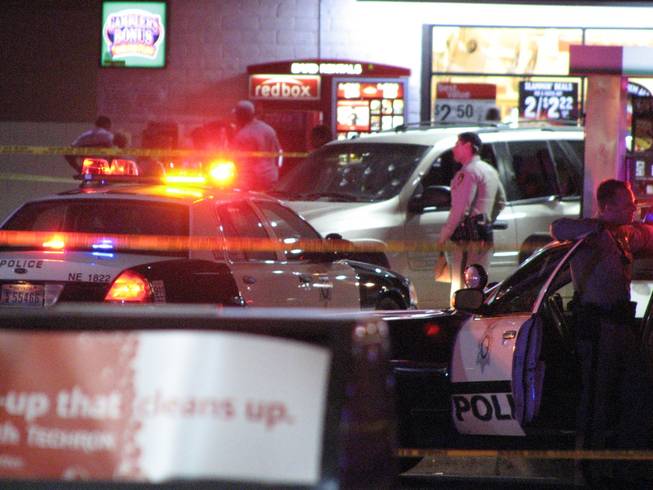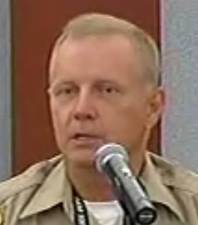
Martin Dean Dupalo / Courtesy photo
Metro Police gather outside a convenience store where officers exchanged gunfire with a man suspected of committing multiple armed robberies. The suspect was killed.
Published Wednesday, Oct. 20, 2010 | 10:59 p.m.
Updated Thursday, Oct. 21, 2010 | 4:39 p.m.

Metro Police Officer Jeffery Abell testifies Thursday.
Sun Archives
Metro Police Officer Jeffery Abell said today he wouldn’t have done anything differently the night he and his partner fatally shot a man in front of a 7-Eleven store near Nellis and Charleston boulevards.
“He was shooting at my partner,” Abell said from the witness stand Thursday. “I was in fear for his life.”
Abell and his partner, Breck Hodson, were found justified Thursday in the fatal shooting of Robert B. Mills III, who was shot to death about 11 p.m. Aug. 27 inside his vehicle after, Abell said, Mills fired at Hodson. Mills was pronounced dead at University Medical Center.
After the shooting, Metro identified a third officer, Nathan Jones, as being involved. Homicide Detective Jeff Rosgen, who investigated the shooting, said none of the bullets Jones fired fatally struck Mills.
Wendy Whitfield, Mills’ common-law wife of about four years, testified Thursday that she and her husband had fallen on hard times. They had no money and had recently lost their home and their car. Mills was on methadone for pain management for neuropathy, she said. His doctor had recently put him on disability for the neuropathy and other medical conditions and he was unable to work, she said.
“We were essentially homeless,” she said. “He was very depressed and upset about the fact that he couldn’t provide for his family.”
Whitfield said about a week before Mills was shot, he had talked with her about possibly committing robberies to make money. She testified that she told him if he did commit a robbery, she would leave him.
“The only way he could think of to earn money was to rob. I told him he needed to think of his family and that that wasn’t the way to do it,” she said.
A statement Whitfield made to police the night of the shooting was played for the jury. In it, she tells the officer that her husband had told her he wouldn’t go back to prison.
“He told me he’d never go back to jail, he said he’d make you guys shoot him first,” she told the officer.
She testified that her husband was desperate.
“He did what he did because he was a desperate man – a desperate man who could no longer provide for his family, due to his mental illnesses and his physical illnesses,” she said, crying softly. “I’m not saying that what my husband did was right, but at the same time, he did what he thought he had to do to provide for his family.”
Abell testified that he and Hodson initially responded to a report of an armed robbery in the casino area of the Smith’s grocery store at Nellis and Stewart Avenue. When they arrived at the store, the robber had already left. Abell said he and Hodson, along with the store manager, reviewed surveillance video and provided dispatchers with an updated description of the suspect: a white or Hispanic man, about 5-foot-8, 180 pounds with a heavy-set build, wearing a black bandana.
They learned the robber left the store in a gold-colored sport utility vehicle after firing one shot into the air, Abell said.
When robbery detectives arrived, Abell and Hodson, both assigned to the Northeast Area Command’s problem-solving unit, returned to their vehicle – an unmarked white Chevrolet Impala – and left the scene. As soon as they started driving, a second call came over the radio for an armed robbery, this time at the Sunrise Food Mart convenience store near Charleston Boulevard and Sloan Lane. That location is about one mile away from the Smith’s grocery store.
Over the police radio, it was reported that this time, the robber had fired shots at the store clerk. Abell and Hodson started driving to the Food Mart, but en route learned the robber had left. They started watching for the gold SUV as they canvassed the neighborhood. It wasn’t long until they spotted a gold SUV parked at a pump at the 7-Eleven at Nellis and Charleston, Abell said.
The duo pulled in to a pump behind the vehicle to get a look at the license plates and updated dispatchers that they had possibly located the vehicle connected to the robbery.
After pulling up behind the SUV, Hodson said Mills looked at him with what he described as a “thousand-yard stare,” and he knew he had to react quickly. He jumped out of his police car and began approaching the SUV, issuing commands to the driver to show his hands.
Although he and Abell were in plain clothes, they were wearing badges around their necks and verbally identified themselves as police officers, he said.
As Hodson approached the driver-side door, he said he saw the man inside the SUV reach toward him with a gun.
“At that point, my life was in danger, as well as my partner’s,” he said. His “only option,” Hodson said, was to shoot him. Hodson testified that he had no choice but to fire at Mills 14 times because the man presented a “severe threat.”
Jones, a patrol officer, said he arrived on the scene in his marked patrol car with his lights flashing shortly after Hodson and Abell did.
“As soon as I pulled in, he (Mills) turned his eyes toward me and looked in my direction,” Jones said of Mills. “Immediately, I saw flashes and heard bangs, which I knew to be gunshots.
“I assumed he was shooting at me,” he said.
At that point, Jones lay down in the front passenger seat of his patrol car. He continued to hear gunfire, so he unholstered his gun and started to shoot at the suspect. He fired, through his windshield, seven times, he said.
Rosgen testified that firing through both the windshield of the patrol car and the windshield of the SUV significantly slowed the bullets. Analysis of the firearms used by the different officers indicated that none of the bullets that entered Mills’ body came from Jones’ gun, Rosgen said.
Recovered on the ground near the driver-side door of SUV was a Smith & Wesson six-shot revolver, of which five cartridges had been fired. One cartridge remained inside the gun.
Inside the SUV, investigators found a black beanie cap, a black bandana, blue surgical gloves and loose dollar bills. The total amount found in the vehicle and on Mills’ body was $99, Rosgen said.
Abell said Hodson approached the driver-side door and started yelling commands as Abell approached the passenger side.
He said he heard his partner yelling at the vehicle, which was hard to see inside because it had tinted windows.
Hodson yelled, “Metro police! Let me see your hands, let me see your (expletive) hands!” Abell testified.
“The driver immediately shot out toward the driver-side window,” Abell said. “I saw a flash and I heard a shot.”
Abell said he and his partner both fired at the man, who remained inside the SUV, firing back, multiple times. At one point, Abell said, the man reached a clenched fist out the driver-side window in a “shooting motion” which Abell presumed was to fire at his partner.
Although Abell didn’t see the gun, “there was no doubt in my mind that he was armed and had a gun,” he said.
Hodson testified he never heard shots or saw muzzle flashes, but said he saw the man take aim at his partner and at himself. Because the man presented himself as a deadly threat, deadly force was the appropriate response, Hodson said.
Abell engaged in gunfire with the man at least three times, he said, and fired 16 bullets. He had to reload his weapon at least once.
Metro identified the three officers involved in the shooting as Jones, 27, who has been with the department since January 2006; Abell, 46, with the department since June 2005; and Hodson, 29, with the department since January 2006. All three are assigned to the Northeast Area Command post.

Dr. Lisa Gavin, medical examiner with the coroner's office, testifies Thursday in the inquest of Robert B. Mills II, who was killed by Metro Police Aug. 27.
Dr. Lisa Gavin, a medical examiner with the Clark County Coroner’s Office, testified that Mills died from multiple gunshot wounds. The manner of death was ruled a homicide.
Ten shots entered his body from back to front, she said, and he had an eleventh wound she described as a “graze wound.”
A toxicology screening conducted as part of the autopsy indicated Mills had a high level of methadone in his system when he died – levels that could be lethal unless someone had built up a tolerance.
Methadone, Gavin said, can be used for treating dependence on heroin or other opiates, or for pain management, she said.
The coroner’s inquest is a fact-finding process that takes place any time a person dies at the hands of law enforcement. A jury hears testimony and decides whether the death was justified, excusable or criminal.
In this case, jurors deliberated for about 30 minutes and were unanimous in their verdict. Coroners’ juries don’t have to be unanimous in their findings to reach a ruling.
Las Vegas Justice of the Peace Melanie Andress-Tobiasson presided over the inquest. Witnesses, which included a number of customers at the store who witnessed the shooting and other officers who had responded to the scene, were questioned by deputy district attorneys Christopher Laurent and David Stanton.
The inquest comes on the heels of an inquest into the controversial police shooting death of Erik Scott, who was killed outside the Summerlin Costco in May. The inquest process has been under scrutiny and a county panel has been evaluating possible reforms.
The hearing was broadcast live on Clark County Television, Channel 4.

Join the Discussion:
Check this out for a full explanation of our conversion to the LiveFyre commenting system and instructions on how to sign up for an account.
Full comments policy